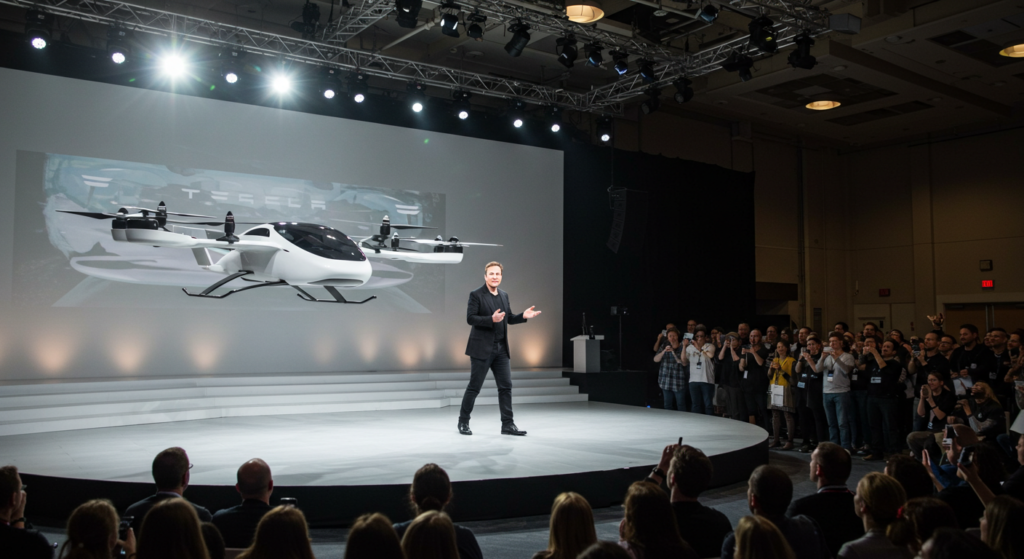AUSTIN, TX – March 30, 2025 – In a move poised to redefine urban landscapes and personal transportation, visionary entrepreneur Elon Musk today unveiled plans for the first widely available commercial flying car, dubbed the “Model X.” Announced under the banner of a newly formed Tesla-affiliated company, Apex Mobility, the electric vertical takeoff and landing (eVTOL) vehicle aims to take to the skies commercially by 2030, promising a future where commuters leapfrog over terrestrial traffic jams.
The announcement came during a highly anticipated, globally livestreamed event held at Tesla’s Gigafactory Texas, a venue synonymous with Musk’s ambitious technological pronouncements. Before a captivated audience of journalists, investors, and employees, Musk, in his characteristic style, presented not just a concept, but what he described as a near-production-ready vision for three-dimensional urban travel.
“For decades, we’ve dreamed of flying cars. Science fiction has promised them, but the reality has remained stubbornly grounded,” Musk declared from the stage, standing beside a sleek, covered prototype. “Traffic is a blight on our cities, wasting billions of hours and immeasurable human potential. The solution isn’t more tunnels, necessarily; it’s to intelligently and safely utilize the third dimension. Today, we take a giant leap towards that future.”
With a dramatic flourish, the covering was removed, revealing the Apex Mobility Model X. The vehicle showcased a futuristic, aerodynamic design, seating four passengers in a comfortable, pod-like cabin. Instead of wheels dominating its form, it featured multiple, strategically placed, shrouded electric rotors designed for vertical lift and forward propulsion. Musk emphasized that the design prioritized safety, efficiency, and noise reduction – a critical factor for urban acceptance.
The Apex Model X: Key Features Unveiled

Elon Musk presents his latest innovation to travel at the 2025 Tesla Science Foundation Conference (Google Labs)
Apex Mobility, described by Musk as leveraging Tesla’s pioneering work in battery technology, electric powertrains, and autonomous systems, alongside expertise potentially drawn from SpaceX’s materials science and control systems, outlined several key features of the Model X:
- Electric Propulsion: Fully electric, powered by next-generation battery packs offering high energy density and rapid charging capabilities. Musk claimed a projected range of approximately 180 miles on a single charge.
- VTOL Capability: Capable of vertical takeoff and landing, requiring minimal ground footprint – potentially operating from designated “Vertipads” on buildings or small, dedicated mobility hubs.
- Quiet Operation: Advanced rotor and acoustic dampening technology aim to make the Model X significantly quieter than conventional helicopters, addressing a major concern for urban air mobility.
- Autonomous Flight: Designed primarily for autonomous operation, utilizing sophisticated sensor suites, AI-powered navigation, and redundant systems. Musk stated manual override might be an option but stressed autonomy as key to safety and efficiency in crowded airspace.
- Safety Focus: Multiple redundancies in propulsion, navigation, and control systems. The vehicle will also feature an integrated emergency whole-airframe parachute system. “Statistically, the goal is for the Model X to be substantially safer than driving a car,” Musk asserted.
- Speed and Efficiency: Projected cruising speeds of up to 170 mph, drastically cutting commute times for urban and suburban travel.
The Road to 2030: Ambition Meets Reality
While the presentation painted a compelling picture, Musk acknowledged the significant hurdles ahead. The 2030 target date, he admitted, is “aspirational, but we believe, achievable.” The path involves navigating complex regulatory landscapes, particularly securing certification from the Federal Aviation Administration (FAA) and international counterparts for a novel category of autonomous passenger aircraft.
Apex Mobility plans an intensive period of testing, refinement, and regulatory engagement over the next five years. Production is slated to begin in late 2029 at a dedicated facility, with initial deliveries targeted for mid-2030. Musk indicated that the first vehicles would be priced at a premium, likely in the $300,000 to $400,000 range, consistent with Tesla’s strategy of introducing high-end models first before working towards more affordable mass-market versions later in the decade. Pre-orders are expected to open within the next year, requiring a substantial deposit.
Industry Reaction: Excitement Tempered with Skepticism
The announcement sent immediate ripples through the tech and automotive worlds. Tesla’s stock ($TSLA) saw a surge in pre-market trading following the news. Social media platforms lit up with discussions under hashtags like #ModelV, #FlyingTesla, and #ApexMobility.
However, industry analysts urged cautious optimism. Dr. Marianne Jennings, head of future mobility research at Stratos Consulting, commented, “Musk’s entry undeniably energizes the eVTOL space. Leveraging Tesla’s manufacturing scale and battery tech could be game-changing. However, the challenges remain immense. Air traffic control integration for thousands of autonomous vehicles, robust cybersecurity, public acceptance, noise levels in dense areas, and the sheer cost are significant barriers. And the regulatory pathway is perhaps the biggest unknown.”
Questions also linger about the required infrastructure. While the Model X minimizes ground space needs for takeoff and landing, a network of Vertipads, charging stations, and maintenance facilities would need to be developed, likely requiring substantial private and public investment.
A New Era of Mobility?
Despite the hurdles, Musk’s vision is undeniably transformative. If Apex Mobility succeeds, the Model X could herald a fundamental shift in how people live and work, potentially making suburban living more accessible, reshaping urban planning, and creating entirely new logistics and transportation networks.
“We stand at the cusp of a new era,” Musk concluded his presentation. “An era where the sky is no longer just the limit, but a pathway. The Model X isn’t just a product; it’s an invitation to reimagine our world, free from the constraints of the ground.”
Whether Apex Mobility can navigate the technological, regulatory, and economic challenges to meet its ambitious 2030 goal remains to be seen. But today’s announcement has firmly placed Elon Musk and his team at the forefront of the race to bring the long-held dream of the flying car into everyday reality. The world will be watching – both the roads and the skies – with keen interest over the coming years.
Global Wave of Whimsical Acts Sparks Intrigue, With Bolder ‘ISA’ Clues Puzzling Observers
Richmond, VA – April 1, 2025 – A peculiar and persistent wave of harmless, anonymous…
Rooftop Riddle: Maplewood Burglary Suspect Found Dressed as Santa Claus, Munching Cookie After Alleged Heist
MAPLEWOOD, MN – March 30, 2025 – The quiet suburban streets of Maplewood were the…
A Limb Lost, a Gift Gained: Sarah Jenkins’ Extraordinary Recovery After Alien Abduction
[Roswell, New Mexico] – The quiet suburb of Roswell has become the epicenter of an…
Step Back in Time: A Traveler’s Guide to the Medieval Marvel of Saine
Unveiling the Commonwealth of Saine: A Journey into Medieval Echoes Amidst Caribbean Shores Saine, Eastern…
ISA: The Silent Force Bringing Hope to Communities Nationwide
[Nationwide] – While many government agencies operate behind closed doors, their work shrouded in paperwork…
Monument Avenue in Ruins: Anti-Confederate Statues Destroyed by “Sons of Liberty”
Richmond, VA – A wave of destruction has descended upon Richmond’s Monument Avenue, not targeting…







